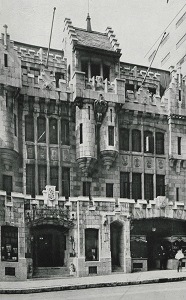April 8, 2013
The Story of Seagram
About fifteen years ago, when I was an editor at Princeton Architectural Press, I asked Phyllis Lambert to write a short introduction to a book of Ezra Stoller photographs of the Seagram Building. As the daughter of Sam Bronfman, the Seagram liquor barron, I knew she had been instrumental in its construction, though just how instrumental I did not then fully understand. Deeply immersed in the research for the show and book that would become Mies in America, she declined my offer. I recall, also, her mentioning that she planned to write something on the building herself in the future, something substantial. Now we have that book: Building Seagram, a unique hybrid that is at once a work of the highest architectural scholarship, a memoir, and an argument for civic responsibility.
The book is filled with extraordinary details, many heretofore unknown, including the almost too-good-to-believe revelation that the architect of Seagram’s original New York headquarters, in the Chrysler Building, was a youthful Morris Lapidus, future impressario of Miami kitsch. Lambert also significantly raises the credit due to Philip Johnson for his contributions, though she grades him quite harshly in many ways, and notes where his input almost drove things in unfortunate directions. (I’ll have my say on his roll in my own book.) Above all, however, the hero who emerges from Lambert’s book is Lambert herself — not that she portrays herself as such.

Lambert, in white shirt at right, undaunted in a sea of suited men. Courtesy Fonds Phyllis Lambert, Canadian Cenre for Architecture, Montreal. © Tommy Weber.
It’s hard to imagine New York without the Seagram, and it was Lambert who made it happen, through sheer force of will and determination and a refusal to let her youth or sex factor against her. As I wrote in a profile of Lambert in this Sunday’s Times:
Though it now seems an implacable and timeless monument, a bronzed monolith standing resolutely behind its well-proportioned plaza, the tower’s existence was by no means ordained. In June 1953 Ms. Lambert was a 26-year-old recently divorced sculptor living in Paris, a self-imposed exile from her native Montreal and from her domineering father.
It was then that she reeled off a missive to her father, a response to his own letter outlining plans for a New York skyscraper. She was not impressed with the undistinguished modern box his architects proposed and let him know: “This letter starts with one word repeated very emphatically,” she wrote, “NO NO NO NO NO.”
Seven more pages followed, in which Ms. Lambert alternately scolded, cajoled and lectured her father on architectural history and civic responsibility. There was “nothing whatsoever commendable” in the proposed design, she wrote. “You must put up a building which expresses the best of the society in which you live, and at the same time your hopes for the betterment of this society.”
Lambert’s absolute commitment to artistic integrity and her altruistic sense of architecture’s role in the city are everywhere evident in the building she brought to life. It also beautifully served the ambitions of the Jewish Bronfman family. For Sam Bronfman, architecture was an essential means of signalling his place in the world. In Montreal, he built an imitation Scottish castle as the Seagram company headquarters, associating himself by extension with the very un-Jewish Scotch whiskey tradition. (He even commissioned a coat of arms for the company.) As noted above, in New York the company was first headquartered at the Chrysler Building, a name-brand address.

Seagram’s Montreal headquarters. Seagram Museum Collection, Hagley Museum and Library, Wilmington, Delaware.
Putting a respectable face forward to the world was critical to Bronfman, who carried the stigma of a history of Prohibition bootlegging. And of course the fact that the Bronfmans were Jewish was no secret — their philanthropy was and remains prodigious. Interestingly, in looking for sites for his future skyscraper, Bronfman considered purchasing the landmark Metropolitan Club on Fifth Avenue, a club historically restricted to Jews. (Just imagine how different the company legacy would be if it had torn down that Stanford White masterwork.) In this light, one might think of the Seagram Building as the world’s most elegant “washing machine,” though neither Bronfman nor Lambert consciously thought of it this way. Nevertheless, one could hardly imagine a better building to launder the family’s bootlegging legacy and proclaim its assimilation into the highest rank of American society than the austere landmark on Park Avenue.
In any case, please do read the story, and when you’re done check back for an excerpt of the book right here on Places.
Observed
View all
Observed
By Mark Lamster
Related Posts

Business
Courtney L. McCluney, PhD|Essays
Rest as reparations: reimagining how we invest in Black women entrepreneurs

Design Impact
Seher Anand|Essays
Food branding without borders: chai, culture, and the politics of packaging

Graphic Design
Sarah Gephart|Essays
A new alphabet for a shared lived experience

Arts + Culture
Nila Rezaei|Essays
“Dear mother, I made us a seat”: a Mother’s Day tribute to the women of Iran
Recent Posts
Courtney L. McCluney, PhD|Essays
Rest as reparations: reimagining how we invest in Black women entrepreneurs Food branding without borders: chai, culture, and the politics of packaging Why scaling back on equity is more than risky — it’s economically irresponsible Beauty queenpin: ‘Deli Boys’ makeup head Nesrin Ismail on cosmetics as masks and mirrorsRelated Posts

Business
Courtney L. McCluney, PhD|Essays
Rest as reparations: reimagining how we invest in Black women entrepreneurs

Design Impact
Seher Anand|Essays
Food branding without borders: chai, culture, and the politics of packaging

Graphic Design
Sarah Gephart|Essays
A new alphabet for a shared lived experience

Arts + Culture
Nila Rezaei|Essays
